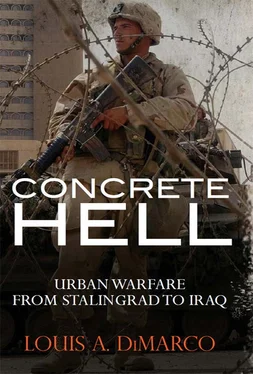Future urban military operations, as the historical record supports, will not just be about urban combat. Because the civilian population is integral to the urban environment, urban combat must be closely and effectively coordinated and synchronized with political policy. It will not be possible to execute truly successful urban combat operations unless those operations account for the welfare of the civilian population, and political policy ensures that the needs and grievances of urban residents are adequately satisfied. To help accomplish this, military leaders must carefully plan urban combat operations in conjunction with political guidance so that, unlike the French in Algiers, military victory does not contribute to political defeat.
One of the keys to the success of urban combat is to ensure that military forces conducting urban combat represent the urban population. This may be impossible for a foreign military force to achieve, therefore it is imperative that any military operations in urban areas are conducted by combined forces that include representatives of the urban population. General MacArthur understood that the politics of urban combat are as important as the tactics, and he therefore ensured that the X Corps included a small but very politically important South Korean military component. Similarly, 1BCT of 1st Armored Division ensured that all of its operations in Ramadi included elements of the Iraqi army and if possible the Iraqi police; not for their military capability but for the legitimizing influence they had with the civilian population; and for the political effects that Iraqi army success had on the stability of the Iraqi government. Commanders in urban combat must always remember that war is for political purposes, and in urban combat political purposes often are more important than tactical military requirements.
Urban combat has been a critical facet of warfare since the beginning of recorded military history. It dominated warfare for most of history. As modern militaries enter the 21st century they should understand that urban combat is again the dominant characteristic of war. This change is, however, not a sudden development. The trend of military history since World War II clearly shows the increasing frequency and decisiveness of urban combat. Similarly, military history also contains many of the secrets for understanding and operating in the complex urban environment of the future.
Alexander, Joseph H. Battle of the Barricades. US Marines in the Recapture of Seoul. Marines in the Korean War Commemorative Series. Washington DC: US Marine Corps Historical Center, 2000.
Arnold, James R. Tet Offensive 1968: Turning Point in Vietnam. Oxford: Osprey Publishing, 1990.
Aussaresses, Paul. The Battle of the Casbah. Terrorism and Counter-Terrorism in Algeria, 1955–1957. New York: Enigma Books, 2002.
Beevor, Antony. Stalingrad. Tateful Siege: 1942–1943. New York: Penguin Putnam Inc., 1998.
Campbell, Duncan B. Besieged. Siege Warfare in the Ancient World. Oxford: Osprey Publishing Ltd., 2006.
Campell, Duncan. Siege Warfare in the Roman World, 146 BC–AD 378. Oxford: Osprey Publishing Ltd., 2005.
Condon, John P. and Mersky Peter B. Corsairs to Panthers. US Marine Aviation in Korea. Marines in the Korean War Commemorative Series. Washington DC: US Marine Corps Historical Center, 2002.
Cordesman, Anthony H. Arab-Israeli Military Forces in an Era of Asymmetric Wars. Stanford, CA: Stanford University Press, 2008.
Couch, Dick. The Sheriff of Ramadi. Navy Seals and the Winning of al-Anbar. Annapolis, MD: Naval Institute Press, 2008.
Craig, William. Enemy at the Gates: The Battle for Stalingrad. Old Saybrook, CT: Konecky and Konecky, 1973.
Davis, Paul K. Besieged: 100 Great Sieges From Jericho to Sarajevo. Oxford: Oxford University Press, 2003.
Deane, Tony. “An Interview with COL Tony Deane, Part I” and “An Interview with COL Tony Deane, Part II.” Interviewed by Laurence Lessard (Fort Leavenworth, Kansas, September 3, 2008). Operational Leadership Experiences in the Global War on Terror, http://cgsc.contentdm.oclc.org/cdm/search/collection/p4013coll13(accessed June 11, 2012).
Dewar, Michael. The British Army in Northern Ireland. London: Guild Publishing, 1985.
Duffy, Christopher. Fire & Stone. The Science of Fortress Warfare, 1660–1860. Mechanicsburg, PA: Stackpole Books, 1996.
Duffy, Christopher. Siege Warfare. The Fortress in the Early Modern World, 1494–1660. London: Routledge, 1979.
Edwards, Aaron. The Northern Ireland Troubles. Operation Banner , 1969–2007. Oxford: Osprey Publishing, 2011.
Folkestad, William B. The View from the Turret: The 743rd Tank Battalion in World War II. Shippensburg, PA: Burd Street Press, 2000.
Geraghty, Tony. The Irish War: The Hidden Conflict between the IRA and British Intelligence. Baltimore, MD: John Hopkins University Press, 1998.
Glantz, David M. and House, Jonathan M. The Gates of Stalingrad. Soviet-German Combat Operations, April–August 1942. The Stalingrad Trilogy, Volume I. Lawrence: University Press of Kansas, 2009.
Gravett, Christopher. Medieval Siege Warfare. Oxford: Osprey Publishing Ltd., 1990.
Hammel, Eric. Fire in the Streets. The Battle for Hue, Tet, 1968. New York: Dell Publishing, 1991.
Holl, Adelbert. An Infantryman in Stalingrad, from 24 September 1942 to 2 February 1943 (Trans. Jason D. Mark and Neil Page). Sydney: Leaping Horseman Books, 2005.
Horne, Alistair. A Savage War of Peace: Algeria, 1954. New York: Penguin Books, 1977.
Human Rights Watch. Jenin: IDF Military Operations (Vol. 14, No. 3 [E]). 2002.
Israel Ministry of Foreign Affairs. IDF Operations Overnight (3–4 April) in Judea and Samaria. April 4, 2002. http://www.mfa.gov.il/MFA/Government/Communiques/2002/IDF+operations+overnight+-2-3+April-+in+Jenin+and.htm(accessed November 5, 2011).
Israel Ministry of Foreign Affairs. Jenin’s Terrorist
Infrastructure. April 4, 2002. http://www.mfa.gov.il/MFA/MFAArchive/2000_2009/2002/4/Jenin-s%20Terrorist%20Infrastructure%20-%204-Apr-2002(accessed November 5, 2011).
Kyle, Chris, with McEwen, Scott and DeFelice, Jim. American Sniper. The Autobiography of the Most Lethal Sniper in US Military History. New York: Harper Collins, 2012.
MacDonald, Charles B. United States Army in World War II, The European Theater of Operations: The Siegfried Line Campaign. Washington, DC: Center of Military History, 1984.
MacFarland, Sean. “An Interview with Colonel Sean MacFarland.” Interview by Steven Clay (Fort Leavenworth Kansas, January 17, 2008). Contemporary Operations Study Team, On Point III.
Malkasian, Carter and Marston, Daniel (eds.). Counterinsurgency in Modern Warfare. Oxford: Osprey Publishing, 2008.
Matt, Rees. “Untangling Jenin’s Tale,” in Time (May 13, 2002). http://www.time.com/time/magazine/article/0,9171,1002406,00.html (accessed 5 November, 2011).
Michaels, Jim. A Chance in Hell: The Men Who Triumphed Over Iraq’s Deadliest City and Turned the Tide of War. New York: St Martin’s Press, 2010.
Ministry of Defense. Operation Banner . An Analysis of Military Operations in Northern Ireland. UK: Ministry of Defense, 2006.
Newsinger, John. British Counter insurgency, From Palestine to Northern Ireland. New York: Palgrave, 2002.
Nolan, Keith William. Battle for Hue, Tet, 1968. Novato, CA: Presidio Press, 1983.
Oliker, Olga. Russia’s Chechen Wars 1994–2000: Lessons From Urban Combat. Santa Monica, CA: Rand, 2001.
Читать дальше












